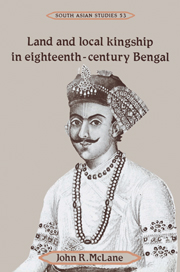Book contents
- Frontmatter
- Contents
- List of tables
- Preface and acknowledgments
- List of abbreviations
- Select glossary
- Map of southwest Bengal
- Part I Bengal
- Part II Burdwan
- 6 Mughal Burdwan and the rise of the Burdwan raj
- 7 Burdwan's expansion
- 8 The Maratha invasions, 1742-1751
- 9 Zamindars and the transition to Company rule
- 10 The famine of 1770
- 11 Revenue farming, 1771-1777
- 12 Zamindari family politics: the Burdwan raj, 1770-1775
- 13 The politics of Burdwan family debt and marriages, 1775-1778
- 14 Testing the limits, 1778–1790
- 15 Burdwan under the Decennial and Permanent Settlements
- 16 Patnis and the elusive quest for independence and security
- 17 Conclusion
- Bibliography
- Index
- Cambridge South Asian Studies
12 - Zamindari family politics: the Burdwan raj, 1770-1775
from Part II - Burdwan
Published online by Cambridge University Press: 13 October 2009
- Frontmatter
- Contents
- List of tables
- Preface and acknowledgments
- List of abbreviations
- Select glossary
- Map of southwest Bengal
- Part I Bengal
- Part II Burdwan
- 6 Mughal Burdwan and the rise of the Burdwan raj
- 7 Burdwan's expansion
- 8 The Maratha invasions, 1742-1751
- 9 Zamindars and the transition to Company rule
- 10 The famine of 1770
- 11 Revenue farming, 1771-1777
- 12 Zamindari family politics: the Burdwan raj, 1770-1775
- 13 The politics of Burdwan family debt and marriages, 1775-1778
- 14 Testing the limits, 1778–1790
- 15 Burdwan under the Decennial and Permanent Settlements
- 16 Patnis and the elusive quest for independence and security
- 17 Conclusion
- Bibliography
- Index
- Cambridge South Asian Studies
Summary
The death of Raja Tilakchandra in May 1770 left the Burdwan raj family without an authoritative leader, without a person commanding respect from both major factions within the Burdwan raj who was capable of protecting the family's assets and settling the family's internal disputes. That the bulk of the zamindari was farmed out to ijaradars from 1771 to 1776 may have minimized the damage that the zamindari amla could inflict during the period when the inexperienced young widow, Rani Bishnukumari, was titular head of the family. Yet from 1770 until her death in 1798, controversies swirled around her, one drama followed another. These controversies afford a view into common problems of zamindari family politics in Bengal. This and the following chapter trace the disputes, largely unconnected to revenue matters, that deeply disrupted the lives of Rani Bishnukumari and her young son, Raja Tejchandra.
From the beginning of British administration in Bengal, Company officials tended to act as if zamindars were public servants rather than hereditary lords of privately owned land. If more efficient agents of revenue collection could be found, the zamindars were set aside on handsome stipends. Yet officials recognized that zamindars possessed a genuine authority over the people of their territories as well as hereditary privileges. So even when revenue farmers and other temporary agents were vested with collection rights, the Company employed zamindari officers, zamindari seals and signatures, and the zamindari puniya ceremonies to buttress the Company's authority. When a zamindar died, the Company assisted his successor in gaining a sanad from the Mughal emperor confirming his titles.
- Type
- Chapter
- Information
- Land and Local Kingship in Eighteenth-Century Bengal , pp. 223 - 234Publisher: Cambridge University PressPrint publication year: 1993



